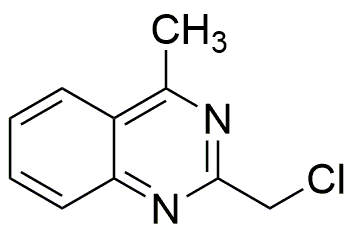2-(Chloromethyl)-4-methylquinazoline is widely utilized in research focused on:
- Synthesis of Pharmaceutical Compounds: This chemical serves as an important intermediate in the synthesis of various pharmaceuticals, particularly those targeting cancer and infectious diseases, enhancing the development of effective treatments.
- Biological Research: It is used in biological studies to investigate the mechanisms of action of quinazoline derivatives, aiding researchers in understanding drug interactions and biological pathways.
- Material Science: The compound is applied in the development of specialized polymers and coatings, offering improved durability and chemical resistance, which is crucial for industrial applications.
- Fluorescent Probes: It can be utilized in the design of fluorescent probes for imaging applications, providing researchers with tools for visualizing cellular processes in real-time.
- Agrochemical Development: This chemical is also explored in the formulation of agrochemicals, contributing to the creation of more effective herbicides and pesticides, which can lead to better crop yields.
General Information
Properties
Safety and Regulations
Applications
2-(Chloromethyl)-4-methylquinazoline is widely utilized in research focused on:
- Synthesis of Pharmaceutical Compounds: This chemical serves as an important intermediate in the synthesis of various pharmaceuticals, particularly those targeting cancer and infectious diseases, enhancing the development of effective treatments.
- Biological Research: It is used in biological studies to investigate the mechanisms of action of quinazoline derivatives, aiding researchers in understanding drug interactions and biological pathways.
- Material Science: The compound is applied in the development of specialized polymers and coatings, offering improved durability and chemical resistance, which is crucial for industrial applications.
- Fluorescent Probes: It can be utilized in the design of fluorescent probes for imaging applications, providing researchers with tools for visualizing cellular processes in real-time.
- Agrochemical Development: This chemical is also explored in the formulation of agrochemicals, contributing to the creation of more effective herbicides and pesticides, which can lead to better crop yields.
Documents
Safety Data Sheets (SDS)
The SDS provides comprehensive safety information on handling, storage, and disposal of the product.
Product Specification (PS)
The PS provides a comprehensive breakdown of the product’s properties, including chemical composition, physical state, purity, and storage requirements. It also details acceptable quality ranges and the product's intended applications.
Certificates of Analysis (COA)
Search for Certificates of Analysis (COA) by entering the products Lot Number. Lot and Batch Numbers can be found on a product’s label following the words ‘Lot’ or ‘Batch’.
*Catalog Number
*Lot Number
Certificates Of Origin (COO)
This COO confirms the country where the product was manufactured, and also details the materials and components used in it and whether it is derived from natural, synthetic, or other specific sources. This certificate may be required for customs, trade, and regulatory compliance.
*Catalog Number
*Lot Number
Safety Data Sheets (SDS)
The SDS provides comprehensive safety information on handling, storage, and disposal of the product.
DownloadProduct Specification (PS)
The PS provides a comprehensive breakdown of the product’s properties, including chemical composition, physical state, purity, and storage requirements. It also details acceptable quality ranges and the product's intended applications.
DownloadCertificates of Analysis (COA)
Search for Certificates of Analysis (COA) by entering the products Lot Number. Lot and Batch Numbers can be found on a product’s label following the words ‘Lot’ or ‘Batch’.
*Catalog Number
*Lot Number
Certificates Of Origin (COO)
This COO confirms the country where the product was manufactured, and also details the materials and components used in it and whether it is derived from natural, synthetic, or other specific sources. This certificate may be required for customs, trade, and regulatory compliance.


